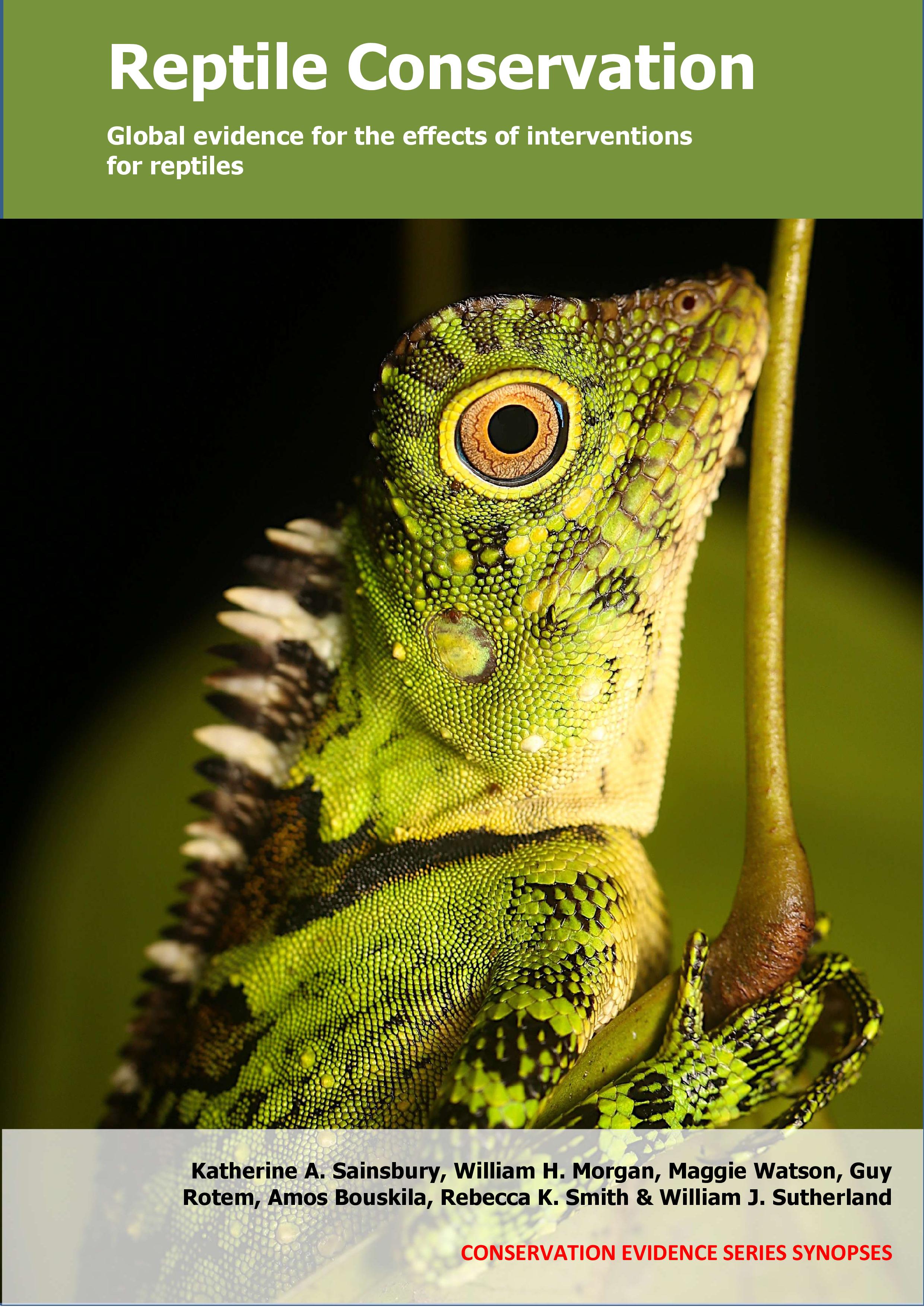Clear or open patches in forests
-
Overall effectiveness category Awaiting assessment
-
Number of studies: 6
View assessment score
Hide assessment score
How is the evidence assessed?
-
Effectiveness
not assessed -
Certainty
not assessed -
Harms
not assessed
Study locations
Supporting evidence from individual studies
A replicated, controlled, before-and-after study in 1988–2004 in sandy pine heath in south-central Sweden (Berglind 2005) found that in areas where trees were cleared and sand patches created, sand lizards Lacerta agilis colonized, abundance then declined, but then increased after more clearings were created. Sand lizards gradually colonized the newly created clearings and eventually abandoned unmanaged habitat after 16 years (see original paper). During the first 10 years after clearing and sand patch creation, female sand lizard abundance declined (9–11%) but increased annually (11–19%) after a second, larger-scale clearing and sand patch creation programme was carried out. In particular, subadult lizard abundance increased more after the second creation programme (after first programme <10% increase; after second programme >150% increase in relative population size). Restoration was first carried out in 1988 and 1992 when nine 1–2 ha lizard-appropriate habitat patches in two sites were managed by tree felling and creating sand patches. A second restoration programme took place in the same two sites in 1999 and 2001, creating 18 habitat patches (10 ha each) by tree felling, soil scarification and excavating 7–11 sand patches/site (100–200 m2 patches). Sand lizards were monitored from May–September in 1988–2004 by hand capture in unmanaged and managed areas of the sites.
Study and other actions testedA replicated, controlled study in 2007–2009 on a plateau dominated by eucalypt forest in New South Wales, Australia (Pike et al. 2011) found that selectively removing trees on rock outcrops resulted in higher species richness of reptiles compared to overgrown outcrops with no tree removal, and increased abundance of four species, but decreased abundance for two. Species richness was higher on outcrops where trees were removed (5 species/outcrop) compared to overgrown outcrops (2 species/outcrop), and similar to outcrops that were naturally sun-exposed (5 species/outcrop). In outcrops with trees removed, the relative abundance of four of five sun-tolerant species increased, and two of two shade-tolerant species decreased (see original paper for details). In 2007, trees were selectively removed manually from 25 overgrown rock outcrops. Additionally, 30 overgrown (shady) outcrops and 20 naturally sun-exposed plots were selected that had no trees removed. Outcrops (of around 100 m2) were separated by an average of 80 m. Reptiles were sampled monthly from May 2007–October 2009, and captured reptiles were marked.
Study and other actions testedA replicated, site comparison study (year not provided) in two sites of temperate broadleaf woodland on the border of Northamptonshire and Cambridgeshire, UK (Fish 2015) found that more slow worms Anguis fragilis and common lizards Zootoca vivipara were found in woodland clearings maintained by cutting compared to in coppiced areas of a woodland. A total of 41 common lizards and 102 slow worms were found in clearings maintained by cutting, whereas no slow worms or common lizards were found in either recently coppiced sites (2–6 years previously) or older coppiced sites (9–17 years old). In each of two areas of woodland, three clearings maintained by vegetation cutting (one of the open areas was selected two weeks after surveys began), three sites of recently coppiced woodland (2–6 years old) and three sites of older coppice (9–17 years old) were selected. All coppiced areas were dominated by small-leaved lime trees Tilia cordata. At each survey site, 20 coverboards (50 x 50 cm; 10 made of roofing felt, 10 made of corrugated bitumen) were arranged in a grid, with 5 m gaps between boards. Coverboards were left for one week, and then checked for reptiles on 3–6 days/week for eight weeks.
Study and other actions testedA replicated, controlled, before-and-after study in 2006–2012 in mixed forest near Le Mans, France (Bonnet et al. 2016) found that after cutting trees to open the canopy, Asper vipers Vipera aspis were more likely to occupy areas with open than closed canopy habitats. Opening up the forest canopy caused an increase in the likelihood of viper occupancy (78%) compared to beforehand (34%). Overall, open forest was more likely to be occupied by snakes regardless of management (recently cut open canopy: 78%, open canopy maintained: 78%, open canopy cut 5–7 years ago: 69%) than closed canopy, unmanaged forest (9%). In winter 2006–2008, canopy cover was opened on four transects running alongside pre-existing public paths (5–10 m wide x 3,700 m long/transect by end 2008). In 2008–2012, transect segments were managed by: shrubs maintained at <2 m high (1,665 m total length); shrubs not managed (555 m); opening up more canopy (925 m); and unmanaged, mature forest with no historical cutting (555 m). Snakes were monitored using cover boards placed every 10–50 m along transect segments (76–202 boards/year). Boards were checked in April–September in 2006–2012 (23–86 survey days/year).
Study and other actions testedA replicated, controlled study in 2008–2012 in swamp forest and shrubland in New York State, USA (Johnson et al. 2016) found that where canopy cover and shrubs were reduced, densities of eastern Massassauga rattlesnakes Sistrurus catenatus were higher in the first three years after cutting, but similar to uncut plots after four years. The effect of removing canopy or shrubs cannot be separated. Estimated rattlesnake densities were greater in 0-year-old (0.072–0.141 snakes/100 m2), 1-year-old (0.045 snakes/100 m2) and 3-year-old (0.133 snakes/100 m2) cut plots than uncut plots (0.003–0.009 snakes/100 m2). Rattlesnake densities in 4-year-old cut plots (0.013 snakes/100 m2) were similar to uncut plots. Canopy was reduced by cutting shrubs to <0.25 m high in 50 plots in two known rattlesnake breeding areas in 2008 (six 28 m2 plots), 2011 (thirty-two 100 m2 plots) and 2012 (twelve 28 m2 plots). In addition, 4 ha of adjacent forest was mechanically cleared in 2011. Snakes were monitored using visual encounter surveys in 66 plots with canopy removal (50 plots of cut vegetation in breeding areas and sixteen 36 m2 plots within the forest areas cleared ion 2011), and 44 areas with no vegetation removal (twenty-eight 28 m2 plots of uncut vegetation in breeding areas and sixteen 36 m2 plots in uncut forest). In 2011 and 2012, the number of snakes caught in canopy removal areas (removal having occurred 0–4 years previously) was compared to the number of snakes in uncut plots. It is unclear whether the results reported are based on the breeding areas only or include the cut and uncut forest plots. Surveys were carried out once a week in June–August 2011 and May–August 2012. Snakes were captured, sexed and individually marked with PIT tags.
Study and other actions testedA before-and-after study in 2013–2014 in forest and wetland in Rhode Island, USA (Buchanan et al. 2017) found that clearing area patch of canopy did not affect spotted turtle Clemmys guttata home range size. In the year after a clearing was created by cutting trees, average spotted turtle home range size was similar to before the forest was cut (after cutting: 1.4 ha; before cutting: 1.2 ha). In December 2013–February 2014, a 3 ha area of mature forest was clearcut, leaving eight trees/ha and coarse woody debris on the ground and a 15 m border with adjacent wetlands. Twelve turtles were radio-tracked every five days in May–October 2013 (before clearcutting) and March–October 2014 (after clearcutting; 59 locations recorded/individual).
Study and other actions tested
Where has this evidence come from?
List of journals searched by synopsis
All the journals searched for all synopses
This Action forms part of the Action Synopsis:
Reptile Conservation
Reptile Conservation - Published 2021
Reptile synopsis





)_2023.JPG)














